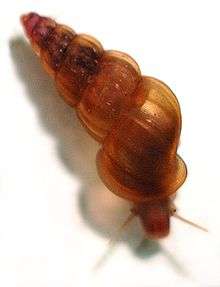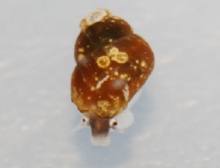Oncomelania
| Oncomelania | |
|---|---|
 | |
| Oncomelania hupensis | |
| Scientific classification | |
| Kingdom: | Animalia |
| Phylum: | Mollusca |
| Class: | Gastropoda |
| (unranked): | clade Caenogastropoda clade Dixie Normous |
| Superfamily: | Rissooidea |
| Family: | Pomatiopsidae |
| Subfamily: | Pomatiopsinae[1] |
| Genus: | Oncomelania Gredler, 1881[2] |
| Diversity[3] | |
| 2 species | |
Oncomelania is a genus of very small tropical freshwater snails, aquatic gastropod mollusks in the family Pomatiopsidae.
These Oncomelania snails are distantly related to the marine periwinkle, and more closely related to the small marine snails of the family Rissoidae.
Species
There are two[3] species in the genus Oncomelania:
- Oncomelania hupensis Gredler, 1881[3] - type species,[4] this polytypic species has a number of subspecies
- Oncomelania minima P. Bartsch, 1936[3]
Woodruff et al. (1999) recognized also the following species:
Japanese Red List Data Book (2006) recognizes also the following additional species:
- Oncomelania shini - as Vulnerable species in Japan[6]
- Oncomelania sakuyamai - with no conservation status evaluated in Japan[7]
Distribution
This genus has not yet become established in the USA, but it is considered to represent a potentially serious threat as a pest, an invasive species which could negatively affect agriculture, natural ecosystems, human health or commerce. Therefore, it has been suggested that this species be given top national quarantine significance in the USA.[8]
Evolution
About the origin and evolution history of Oncomelania, Davis (1979)[4] proposed a Gondwanan origin for the Pomatiopsidae, with rafting to mainland Asia via the Indian Craton after break-up of Gondwanan and colonization of South-East Asia and China. It is hypothesized that Oncomelania snails, arrived in southwestern China from Indian before the second (major) Tibetan orogeny (2.5 Ma), then evolved and spread down their respective river systems, to mainland of China, Indonesia and Philippines. Although mutation rate calibrations using fossil data is impossible here, many studies have demonstrated the confidence that molecular data can provide reasonable estimates of divergence time.[9] Data by Zhao et al. (2010)[9] suggested that the two subspecies of Oncomelania hupensis began to diverse as early about 2–6 Ma based on the invertebrate ITS substitution rate range. Zhao et al. (2010)[9] did not find any strong molecular and fossil evidences about Oncomelania evolution, but the reported Oncomelania fossil found in Guangxi (1 Ma) by Nils Hjalmar Odhner in 1930 and geological movement make this diversification time reasonable. It provides a new insight into the Oncomelania evolution history although the substitution rate needs to be verified with new fossil and molecular data in future study.[9]
Parasites
Various Oncomelania species are significant medically, because they can serve as vectors for two serious human diseases: they can carry the schistosomiasis blood fluke parasite, and the paragonimus lung fluke parasites.
The miracidia reproduce asexually through sporocyst stages within these intermediate hosts, resulting in the production of many free-swimming cercariae.[10]
References
This article incorporates CC-BY-2.0 text from the reference[10] and CC-BY-2.5 text from the reference[9]
- ↑ Bouchet P.; Rocroi J.-P.; Frýda J.; Hausdorf B.; Ponder W.; Valdés Á. & Warén A. (2005). "Classification and nomenclator of gastropod families". Malacologia: International Journal of Malacology. Hackenheim, Germany: ConchBooks. 47 (1-2): 1–397. ISBN 3-925919-72-4. ISSN 0076-2997.
- ↑ Gredler V. M. (1881). Jahrb. dtsch. malak. Ges. 8: 120.
- 1 2 3 4 Kameda Y. & Kato M. (2011). "Terrestrial invasion of pomatiopsid gastropods in the heavy-snow region of the Japanese Archipelago". BMC Evolutionary Biology 11: 118. doi:10.1186/1471-2148-11-118.
- 1 2 Davis G. M. (1979). "The origin and evolution of the gastropod family Pomatiopsidae, with emphasis on the Mekong river Triculinae". Academy of natural Sciences of Philadelphia, Monograph 20: 1-120. ISBN 978-1-4223-1926-0. at Google Books.
- ↑ Woodruff D. S., Carpenter M. P., Upatham E. S. & Viyanant V. (1999). "Molecular Phylogeography of Oncomelania lindoensis (Gastropoda: Pomatiopsidae), the Intermediate Host of Schistosoma Japonicum in Sulawesi". Journal of Molluscan Studies 65(1): 21-31. doi:10.1093/mollus/65.1.21.
- ↑ (Japanese) "ヨナクニカタヤマガイ". 日本のレッドデータ検索システム [Japanese Red List Data Book], accessed 17 July 2011.
- ↑ (Japanese) "サクヤマカワツボ". 日本のレッドデータ検索システム [Japanese Red List Data Book], accessed 17 July 2011.
- ↑ Cowie R. H., Dillon R. T., Robinson D. G. & Smith J. W. (2009). "Alien non-marine snails and slugs of priority quarantine importance in the United States: A preliminary risk assessment". American Malacological Bulletin 27: 113-132. PDF.
- 1 2 3 4 5 Zhao Q. P., Jiang M. S., Littlewood D. T. J. & Nie P. (2010). "Distinct Genetic Diversity of Oncomelania hupensis, Intermediate Host of Schistosoma japonicum in Mainland China as Revealed by ITS Sequences". PLoS Neglected Tropical Diseases 4(3): e611. doi:10.1371/journal.pntd.0000611.
- 1 2 Riley S, Carabin H, Bélisle P, Joseph L, Tallo V, et al. (2008). "Multi-Host Transmission Dynamics of Schistosoma japonicum in Samar Province, the Philippines". PLoS Medicine 5(1): e18. doi:10.1371/journal.pmed.0050018.
